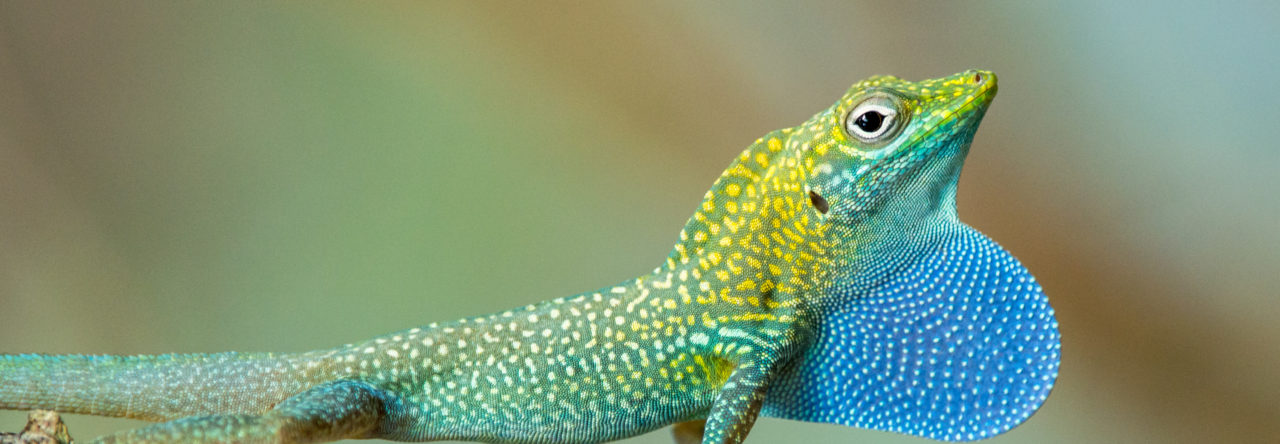
Battling anoles. Image Credits: Ken King // Dixie Native
The St. Augustine Record published a very nice article two weeks ago discussing the invasion of brown anoles, A. sagrei, and how they’ve affected green anoles. But instead of the usual alarmist hysteria–green anoles being pushed to extinction–this article pretty much gets it right!
“…the invasion of the brown anoles have chased the natives into the treetops. The brown anoles, having few enemies, have taken over the former habitat of the greens, forcing them into new territories and farther from our sight.”
That’s right–the green anoles aren’t going extinct, they’re just shifting their habitat use to get away from the browns. The only quibble I would have is that this is not really “a new territory” because not only have green anoles in Florida been using high perches all along, but that’s what their ancestors in Cuba, who’ve always lived with brown anoles, have always done. Green anoles experienced what’s called “ecological release” when they got to Florida and found it brown anole-less; now they’re simply returning to their ancestral niche.
For more on this topic, see previous AA posts [e.g., 1, 2, 3].
- Evolution in Real Time on Lizard Island - March 23, 2025
- Spider Snags Adult Anolis osa - March 22, 2025
- An Homage to the Green Anoles of New Orleans - March 21, 2025


Skip Lazell
Yes. It seems to me this has been known for at least 30 years, since sagrei first became established in S Florida. Skip
Armando Pou
Thank you for this post, it renews my faith that someday general news coverage will take a more scientific approaches and rather than just trying to sell the news.
Frank W. Schena
Article is alright…Well, unless you live in Miami. Greens are common at eye-level in my yard, but not right on the ground. Browns are common in both niches. I’m probably looking at Cuban greens, or ‘super’ porcatus-carolinensis hybrids around here though. Bigger question: Why have I had more or less equal numbers of bark anole floridanus and dominicensis in the yard since I moved here in 2008?
Armando Pou
Hi Frank, I believe what we have in Miami are Anolis distichus floridanis – dominicensis “hybrids”, if they can be called that. The bark anolis here will range from ash grey to greenish yellow and their dewlaps can be from solid white or pale yellow all the way to bright yellow with an orange center. If you are looking to find pure floridanis you may have better luck further up the coast in West Palm near ocean hammocks.
Armando
Frank W. Schena
Hi, Armando,
Thanks for the observations and comments… In my yard both forms are numerous. Usually they fall into two types: #1: Rather larger with bright yellow orange dewlap and a suffusion of yellow green all over, especially the sides. #2: Small, with a whitish- without noticeable yellow, with a grainy, pebbly pattern; the dewlap is white. It seems the front end of this one’s dewlap is more ‘pointy’.
I have noticed behavioral/ niche differences as well. #1 Is often found around the house and ‘casita’, and on the coconut and other larger trunks, often low. #2 Is on smaller branches, especially light colored ones. The backyard, with a thick cover of mostly native trees and shrubs (most purposely planted by me to harbor wildlife- successfully) has both types, with ‘dominicensis’ more easily seen. The front yard, with several wider-spaced trees (all young and small), quite open, I’m sure has only the grey’ (#2) type. The isolated small live oak on the street has several of these, with no #1. Maybe it’s my imagination, but I think the two forms are different enough, in pattern and behavior, to be a separate… I probably shouldn’t say it… species!
Some other notes… Low on the coconut palm I once saw green, brown and the ‘yellow’ bark anoles all basically in the same part of the trunk, each much less than 10 feet from each other. Higher up was one knight anole! My neighborhood is Shenandoah/ Little Havana.
Drop me a line, we should meet up and do some herping!
Frank
Caleb S.
This seems to be what’s happened since the browns invaded my part of Texas.